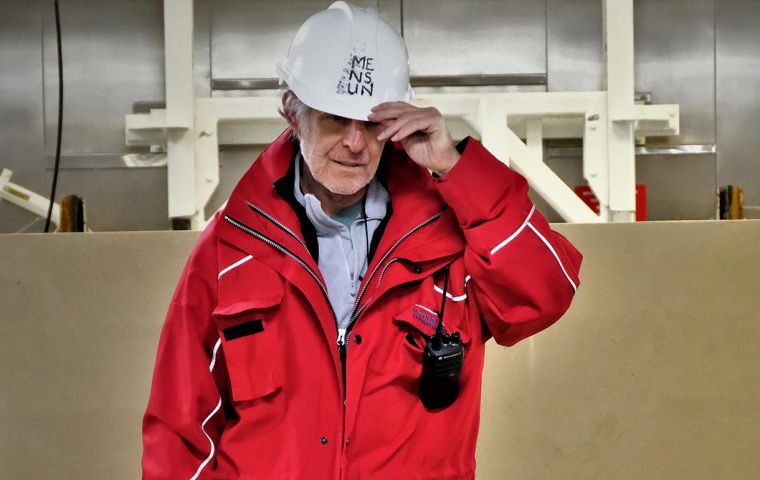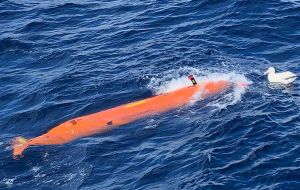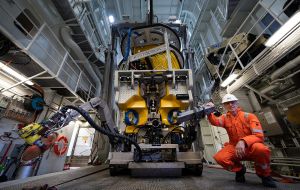MercoPress. South Atlantic News Agency
Searching for Admiral Graf von Spee’s great cruiser fleet sunk at the Falklands Battle
 Falkland Islander and marine archaeologist Mensun Bound on board the Seabed Constructor (Pic. by JulianTrincali and Pierre le Gal )
Falkland Islander and marine archaeologist Mensun Bound on board the Seabed Constructor (Pic. by JulianTrincali and Pierre le Gal )  An albatross comes over to check out an AUV that has just been recoveredI(Pic by Julian Trincali and Pierre le Gal)
An albatross comes over to check out an AUV that has just been recoveredI(Pic by Julian Trincali and Pierre le Gal)  Mensun Bound with Remote Operated Vehicle (ROV) with manipulating arms that can work at depths up to 6000m. It is used by the team to study, film and conduct archaeology on the various sites.
Mensun Bound with Remote Operated Vehicle (ROV) with manipulating arms that can work at depths up to 6000m. It is used by the team to study, film and conduct archaeology on the various sites.  Seabed Constructor,the finest deep-ocean, search-and-survey ship in the world (Pic by Julian Trincali and Pierre le Gal)
Seabed Constructor,the finest deep-ocean, search-and-survey ship in the world (Pic by Julian Trincali and Pierre le Gal) In 2014-2015, to mark the centenary of the Battle of the Falklands, Mensun Bound, a Falkland Islander himself, led an expedition to try to find Admiral Graff von Spee’s lost cruiser squadron in 1914, the whereabouts of which has become one the great mysteries of the maritime world. Now he is resuming the hunt. Mercopress began by asking how it all began.
It all came together in 2012. We had the centenary of the Battle of the Falklands coming up in the Falkland Islands and I was anxious that it be properly observed, but more than that - it was slipping from memory; next to the Argentine Invasion of 1982 it was the most dramatic event in the history of the Islands, but it was not being taught in the school and slowly it was slipping from our collective national memory. I remember putting questions about the Battle of the Falklands, 1914, to some children and none of them had the least idea of what I was talking about. On top of that, the military were making noises about holding one last commemorative parade and then, to save money, letting it quietly slip away. When I was young the two big events were Trafalgar Day on the 21 October, and Battle of the Falklands. We had let go of Trafalgar Day and now military chiefs they were proposing to do the same with December 8th, that of the Battle of the Falklands.
And so I put a notice in the Penguin News proposing a public meeting to make sure that the centenary was properly marked. Since I was only expecting about half a dozen to turn up, I decided to hold it in the dining room at my house wherein I had arranged 10 chairs. I remember the surprise and joy I felt when, at the appointed time, I looked out of my window and saw people just streaming up my garden path. So I quickly arranged to use the Parrish Hall instead.
During an introductory talk I made several proposals, including a new memorial and inviting out the descendants of the Admirals to the Islands for ceremonials. When I had finished speaking I asked for additional ideas and somebody stood up and asked why, as a maritime archaeologist, I didn’t go out and find the ships. I was caught off guard and immediately came up with several reasons why it wasn’t realistic. Depth, equipment and of course cost, would have featured largely in my response. But then later I began to think about it and slowly came around to his way of thinking. Anyway, that was January, the turning point came in August when I met with a friend in a coffee bar in South Kensington. He is a maritime history enthusiast and much bolder than me, and he was the one who made the 2014-15 search, as well as the current one, possible. He actually came to the Falklands with the von Spee and Sturdee families in 2014 and the Falkland Islands Museum made a presentation to him in gratitude.
What are the main differences between the current search and that you led in 2014-15?
In 2014-15 I was working from the Endeavour, an old Royal Navy Cold War submarine chaser disguised as a trawler. It was pretty brutal stuff. She shouldn’t really have been down there off the Falklands where the weather coming at you from Cape Horn is just relentless. The seas were horrendous and at times we thought we were about to be buried. I remember vividly on one occasion in a storm the mate screaming ‘hold on’ and the next moment we were rolled right over on our beam ends. Everything and everybody went flying, and yes I confess it, I was scared; I thought the next wave would surely gulp us down. For five months we searched, but most of the time we were running from storms. We had 60 per cent down time. They were an amazing group of people, but we, the ship and our equipment took an absolute hammering.
Our method last time was a towed system. A side-scan sonar that was pulled along at the end of four or five kilometres of cable, with a fish at the end that you had to hold at 30-40 m above the seabed at a depth of 2500 m. If a pinnacle jumped up before you there were only two things you could do, spool in fast or accelerate the ship. It was nerve-wracking stuff with old technology.
This time we fortunate to have the finest deep-ocean, search-and-survey ship in the world, the Seabed Constructor. It is fitted with a state-of-the-art fleet of Autonomous Underwater Vehicles, or AUVs. Each is a torpedo-shaped package containing side-scan sonars, multi-beam echo sounders, sub-bottom profilers, magnetometers, forward-looking sonars and an array of the most advanced underwater camera systems in the world today. Each can go down to 6000 m and operate at speeds above 6 knots.
We program their inertial navigation systems before launch. They go down as a coordinated swarm so that we can cover vast areas of seabed in a minimum of time. Several days later they return to surface; we then download their payload data to a server that transforms it into a legible format that can then be scrutinized by a team of processors and analysts. And if we find an anomaly, or what we call a Point of Interest, we have two massive deep-water robotic devices with manipulating arms that can go down there, conduct photogrammetry and perform every manner of archaeological procedure with perfect delicacy and millimetre accuracy. As the person who directed the deepest hands-on excavation there has ever been, I can say without equivocation that I have seen the future of underwater archaeology – and it is robots.
Who is in charge of the project?
Although I might be the Project Director, I am undertaking this work for the Falkland Islands Maritime Heritage Trust (Chairman, former Falklands governor Donald Lamont) which is working in close collaboration with Ocean Infinity who operate the ship and own the AUVs. We also stay in close touch with the Falklands Museum and if we find the wrecks we hope to be able to produce 3D models for exhibition in the Museum.
I would also like to pay tribute to the team, there is not an organization like this in the world for its deep-water capability and technical expertise. 11 technicians run the AUVs, 6 operate the ROVs, and then there are 3 surveyors and 8 data-processors and analysts. They all work in 12 hour shifts around the clock. In addition there are the officers, crew and domestic staff. In all we number over 60. And then there are the specialists and support staff in London and Texas. As I said, there isn’t an outfit remotely like this anywhere in the world. And right now everybody is focused on archaeology and finding these ships. From top to bottom I have never known such an inspired and inspiring group of people.
Will you be brining anything up? A ship’s bell for the Museum maybe?
There is an excellent 1914 Battle of the Falklands exhibition at the museum and, yes, it would be nice to be able to include something real from the ships, but – and this is something I want to stress – as before, this is a non-disturbance archaeological search-and-survey. These wrecks are war graves, all our procedures will be conducted with absolute respect and nothing will be touched.
Since the discovery of the Titanic, the Endurance and the fate of Admiral Graf von Spee’s great cruiser fleet have been the two great enduring maritime mysteries of our times. In our search for these ships we are not just seeking new archaeological and historical insights on them, but also, by finding them, we hope to keep their stories alive by telling them, in a new context, to the next generation.
Also, we want to see these wrecks preserved into the future, but to do that we need foundation information, beginning with their locations and a record of their states and dispositions on the seabed. Ultimately we will be seeking their protection in law so that there is no risk of them being plundered, as happened to the Titanic.
What is the main difference between your search for Shackleton’s Endurance in the Antarctic of earlier this year and your search for the lost German fleet today?
The search for Shackleton’s Endurance at the beginning of the year and the hunt for von Spee’s fleet today, present very different challenges. Show me a map of the Weddell Sea and I can put my finger on the Endurance. Show me a map of the Falklands and I can do no more than point to the general area where we believe the battle was fought. With the Endurance the challenge was punching our way through the thickest ice at the very heart of the most hostile sea on the planet, and then being able to create a gap in that ice to be able to launch and recover an Autonomous Underwater Vehicle (AUV) and then be able to monitor it from time to time during its mission. How would the ship, the AUV and ROVs, and indeed ourselves, perform in the most extreme conditions imaginable? it was a question we could not answer until we were there. As it turned out, we were able bludgeon our way through to the site but, in the end, it was our equipment that did not perform to expectation, not us or the ship, nor even our planning.
With Graf von Spee’s fleet, by contrast, the challenge is finding it. The coordinates in the official reports of the battle are incorrect. When the fighting was over they had little idea of where they were and the sky was deeply clouded so they were unable to take sextant observations.
The area in which we believe the ships were lost is huge. Equal in size to West Falkland or New York City. Although these were great fighting ships they none the less present a tiny target. Where to begin and then where to go; it’s all a bit like pinning the tail on the donkey. But if we are systematic and persistent, we will find them.




Top Comments
Disclaimer & comment rulesCommenting for this story is now closed.
If you have a Facebook account, become a fan and comment on our Facebook Page!